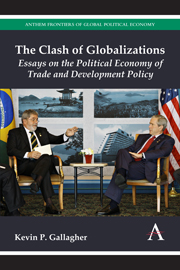Book contents
- Frontmatter
- Dedication
- Contents
- Preface and Acknowledgments
- List of Tables, Figures and Boxes
- Chapter 1 Introducing the Clash of Globalizations
- Chapter 2 Losing Control: Policy Space to Regulate Cross-Border Financial Flows
- Chapter 3 The New Vulture Culture: Sovereign Debt Restructuring and International Investment Rules
- Chapter 4 Whither the Developmental State? Industrial Policy and Development Sovereignty
- Chapter 5 Understanding Developing Country Resistance to the Doha Round
- Chapter 6 Trading Away the Ladder? Trade Politics and Economic Development in the Americas
- Chapter 7 Putting Development First: Trade Policy for the Twenty-first Century
- References
- Index
Chapter 2 - Losing Control: Policy Space to Regulate Cross-Border Financial Flows
Published online by Cambridge University Press: 05 September 2013
- Frontmatter
- Dedication
- Contents
- Preface and Acknowledgments
- List of Tables, Figures and Boxes
- Chapter 1 Introducing the Clash of Globalizations
- Chapter 2 Losing Control: Policy Space to Regulate Cross-Border Financial Flows
- Chapter 3 The New Vulture Culture: Sovereign Debt Restructuring and International Investment Rules
- Chapter 4 Whither the Developmental State? Industrial Policy and Development Sovereignty
- Chapter 5 Understanding Developing Country Resistance to the Doha Round
- Chapter 6 Trading Away the Ladder? Trade Politics and Economic Development in the Americas
- Chapter 7 Putting Development First: Trade Policy for the Twenty-first Century
- References
- Index
Summary
This chapter examines the extent to which measures to mitigate the current crisis and prevent future crises are permissible under a variety of bilateral, regional and multilateral trade and investment agreements. The principal tool that is analyzed are regulations of cross-border finance, a measure traditionally referred to as “capital controls.” Such measures have been important parts of the development toolkit as they can play a role in preventing and mitigating financial crises, to manage exchange rates and to steer credit toward productive development. This chapter shows that the ability to deploy such regulations is fairly constrained under the WTO, but even more so under US trade and investment agreements.
Introduction
Since the Great Depression, and very much so in the run-up to and in the wake of the current financial crisis, some nations have relied on capital controls as one of many possible tools to mitigate or prevent the financial instability that can come with short-term inflows and outflows of capital. In the bubble years before the 2008 global financial crisis became acute, nations such as China, Colombia, India and Thailand regulated inflows of capital in order to stem those bubbles. When the crisis hit, nations like Iceland, Indonesia, Russia, Argentina and Ukraine put capital controls on outflows of capital to “stop the bleeding” related to the crisis (International Monetary Fund 2009).
- Type
- Chapter
- Information
- The Clash of GlobalizationsEssays on the Political Economy of Trade and Development Policy, pp. 13 - 40Publisher: Anthem PressPrint publication year: 2013



